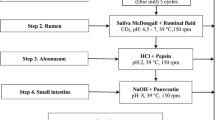Abstract
The agar-gel migration technique has previously been described, however, aspects regarding the effect of timing on worm migration needed further scrutiny. In the first experiment, pigs inoculated with Oesophagostomum dentatum were slaughtered simultaneously and their intestines stored at 21–23 °C until processed pairwise 2, 4, 6, 8, 12 and 18 h after slaughter. More than 95% of the worms migrated out of the agar if processed within 6 h. In the second experiment, intestines were treated immediately after slaughter and the migratory speed of adult worms or 4th-stage larvae of O. dentatum or O. quadrispinulatum, or adult Hyostrongylus rubidus were studied. For both Oesophagostomum species, more than 90% of the worms were recovered within 1 h. H. rubidus was significantly slower; however, approximately 98% of the worms had migrated out of the agar-gel by 20 h. This information is essential in planning experiments where recovery of live worms is of value.
Similar content being viewed by others
Author information
Authors and Affiliations
Additional information
Received: 11 July 1997 / Accepted: 15 September 1997
Rights and permissions
About this article
Cite this article
Nosal, P., Christensen, C. & Nansen, P. Effect of time on migration of Oesophagostomum spp. and Hyostrongylus rubidus out of agar-gel. Parasitol Res 84, 328–332 (1998). https://doi.org/10.1007/s004360050405
Issue Date:
DOI: https://doi.org/10.1007/s004360050405




